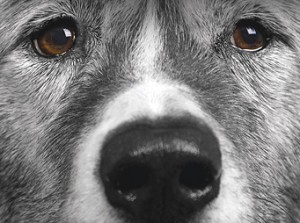A Dog’s Nose Knows
188 – The Annual, 2017-18
by William Given
 The subtleties of color and the visible landscape that dominate perception in the human world are genuinely substituted with scent in the ca- nine panorama. To understand what is going on in the world around them, dogs smell everything. They sniff the ground, the grass and trees. They smell the people they meet and other dogs they encounter. Each of us have observed the importance of smell when it comes to recognition. People and other dogs, who are unknown, are always sniffed thoroughly before being ac- cepted. Scent stimuli also heavily influences dominance, aggression and the sexual behavior of dogs.
The subtleties of color and the visible landscape that dominate perception in the human world are genuinely substituted with scent in the ca- nine panorama. To understand what is going on in the world around them, dogs smell everything. They sniff the ground, the grass and trees. They smell the people they meet and other dogs they encounter. Each of us have observed the importance of smell when it comes to recognition. People and other dogs, who are unknown, are always sniffed thoroughly before being ac- cepted. Scent stimuli also heavily influences dominance, aggression and the sexual behavior of dogs.
For our canine companions, scents are critical signals from the environment. What our dogs do in response to these stimuli goes a long way to accounting for their behavior. That is why so much research is being conducted into the dog’s ability to re- ceive and interpret the olfactory messages from the world in which they live.
BEHIND THE NOSE
With the exception of one, all of the organs responsible for the dog’s incredible sense of smell are tucked away, out of sight, we see only the nose. However, behind the dog’s nose lies a maze of bones and cavities. As the dog breathes, the air is warmed, moistened and filtered. It then travels through this maze of boney folds to where the scent molecules are absorbed into the nasal mucosa. The receptor cells are the major mecha- nisms responsible for olfactory function. They can be found just below the surface where the odorant molecules ooze through the lining of the dog’s nose and bind to the olfactory cilia.
A microscopic examination of the olfactory mucosa reveals a highly complex array cells, but the ones which hold the key to unlocking the mystery of scent detection are the olfactory re- ceptor cells. Depending on the breed, there are between 125 and 300 million of these receptor cells. These receptors serve the combined purpose of capturing the scent molecules and transmitting the resulting signals through a series of connecting nerves to the olfactory bulb in the brain. It is the dog’s nose and brain that allow such sophisticated scent detection and discrimination.
Click here to read the complete article188 – The Annual, 2017-18
Short URL: http://caninechronicle.com/?p=137623
Comments are closed











